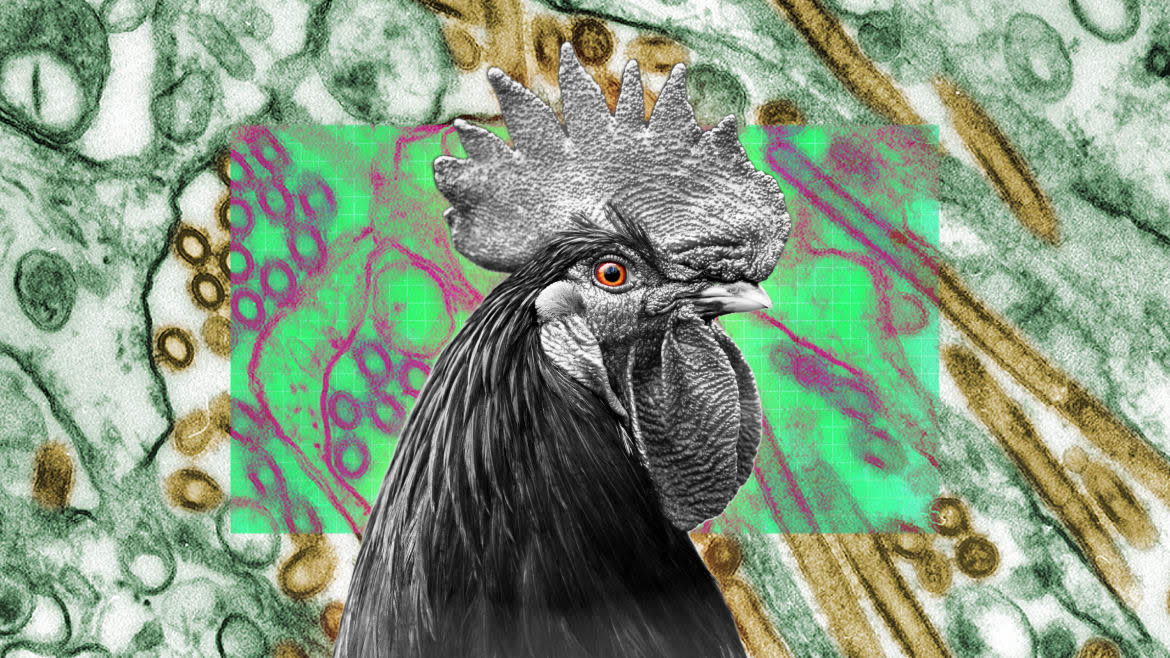Avian Flu Is Already Devastating Bird Populations. Humans May Be Next.

Still suffering from pandemic fatigue? Then you might not yet know about a virus that’s been sweeping the nation. It led to over 50 million deaths in 2022 alone, but don’t panic just yet. These deaths have only affected birds in the U.S. so far. Highly Pathogenic Avian Influenza A (HPAI), a particularly gnarly form of H5N1 influenza, is highly contagious among birds and can have a nearly 100 percent death rate for the winged animals, according to the National Emerging Special Pathogens Training and Education Center.
Avian flu doesn’t jump over to humans very often. The U.S. reported its first human case of HPAI last April, in a person who was involved in culling birds at a farm where H5N1 had been confirmed to infect the poultry. The patient was isolated and recovered after treatment with antivirals, according to the World Health Organization.
But given the right conditions, a few spillover cases can quickly turn into a public health problem of epidemic proportions. Ebola is one example: Since its first description in 1976, the virus has spilled over intermittently to humans in regions where it is endemic. But the worst outbreak of the virus occurred in 2014, where it spread to more than 28,000 people in West Africa, killing more than 11,000.
Nebraska Will Kill Nearly Two Million Chickens After 13th Bird Flu Case
Recent reports that HPAI has infected and killed off thousands of sea lions in South America have concerned researchers that the virus may someday be able to spread between humans or take part in a dangerous melting pot inside a mammalian host.
“We've been thinking a lot lately about this strain because of its potential to be a zoonotic disease” spread from animals to people, Adel Talaat, a microbiology researcher at the University of Wisconsin-Madison, told The Daily Beast. Talaat has been working on vaccine development for avian influenza that one day could be given to poultry.
Wait, we’re vaccinating birds now??
The U.S. has not vaccinated poultry for avian influenza, but researchers including Talaat believe that we should start. He and his team are working on nanovaccines—shots in which active components are very small in size to better induce an immune response. His vaccine will be administered via a spray rather than injection, to more quickly vaccinate large numbers of birds.
Avian Flu Spreads in British Columbia
It’s important to note that the goal with avian vaccination isn’t the same as if it were humans. The birds living on farms that would be vaccinated are just one sliver of the worldwide avian population, so rather than achieve any meaningful form of herd immunity, the goal in vaccinating them would be to minimize economic costs associated with HPAI and bird culling. Methods to vaccinate wild bird populations aren’t practical at this point, Talaat said, leading researchers to focus efforts on what they can feasibly control.
Sea lion cases could be a sign of things to come
Recent reports of sea lions spreading HPAI to one another and dying from the disease are more alarming for humans than they may sound. Researchers typically think about zoonotic diseases in multiple stages, and a series of mutations in the influenza virus are necessary for the pathogen to spread between humans, not just occasionally spill over from birds. That the virus is infecting a species of marine mammal without a hitch means it’s not as far from spreading between humans as we’d like to think.
A second concern surrounding the infection of non-avian animals with HPAI is the threat of antigenic shift. The surface proteins of influenza viruses are what our immune systems recognize and use to produce neutralizing antibodies to match. But over time, these proteins change enough to be rendered unrecognizable. This process can also happen abruptly, when two subtypes of the influenza virus meet in a single host. Antigenic shift notably occurred to produce “swine flu” in 2009. “When shift happens, most people have little or no immunity against the new virus,” according to the Centers for Disease Control and Prevention.
Colorado Prisoner Is First American to Test Positive for H5 Bird Flu Virus, CDC Says
Antigenic shift is a real threat made more likely as the virus continues to infect sea lions, Talaat said. Surveillance is all researchers can do at the moment: “We have to be on the lookout for that—this is the best we can do at this point,” he said.
What happens if the virus jumps over? Am I at risk?
“We have to be ready, and what I mean by that is we have to be ready with a new vaccine,” Talaat said. “These events happen because of the continuous evolution of the virus, and we have no control over it. We don't have fences that prevent us from coming into contact with wild birds.”
The CDC has produced a candidate vaccine virus that, if needed, could be used to make a vaccine for humans. Countries would also have to be ready with a surplus of existing antiviral medications. Besides taking normal precautions for our hygiene and limiting time spent around birds, there isn’t much you or I could do, Talaat said.
Overlapping Virus Outbreaks Threaten ‘Tripledemic’ Crisis
So how worried should I be?
At the moment, it’s a watch and wait scenario.
“Quite frankly, I'm not worried about us in the United States,” Talaat said. Relatively few people are directly involved in handling birds, and the U.S. does not have open-air animal markets, which play a key role in starting and spreading zoonotic outbreaks. But that risk assessment would change if the virus was found to be spreading between humans. “That would definitely be a different story,” he said.
Get the Daily Beast's biggest scoops and scandals delivered right to your inbox. Sign up now.
Stay informed and gain unlimited access to the Daily Beast's unmatched reporting. Subscribe now.

